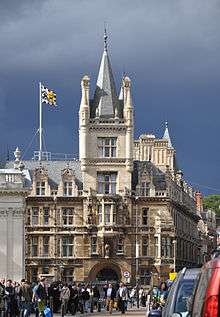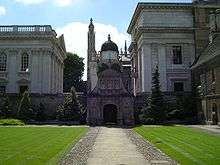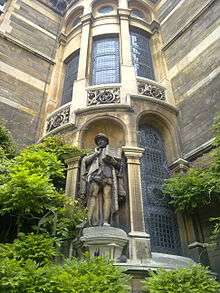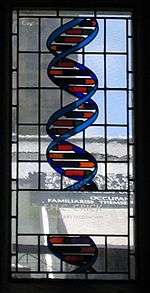Gonville and Caius College, Cambridge
| Colleges of the University of Cambridge | |||||
| Gonville and Caius College | |||||
 | |||||
|
| |||||
| Founders | Edmund Gonville (1348) John Caius (1557) | ||||
| Established | 1348, refounded 1557 | ||||
| Previously named | Gonville Hall (1348–1351) Hall of the Annunciation of the Blessed Virgin Mary (1351–1557) | ||||
| Master | Alan Fersht | ||||
| Undergraduates | 475 | ||||
| Graduates | 230 | ||||
| Sister college | Brasenose College, Oxford | ||||
| Location | Trinity Street (map) | ||||
 | |||||
| College website | |||||
| Student Union website | |||||
| MCR website | |||||
| Boat Club website | |||||
Gonville and Caius College (often referred to simply as "Caius" /ˈkiːz/ KEEZ[1]) is a constituent college of the University of Cambridge in Cambridge, England. The college is the fourth-oldest college at the University of Cambridge and one of the wealthiest. The college has been attended by many students who have gone on to significant accomplishment, including fourteen Nobel Prize winners, the second-most of any Oxbridge college (after Trinity College, Cambridge).[1][2][3]
The college has long historical associations with medical teaching, especially due to its alumni physicians: John Caius (who gave the college the caduceus in its insignia) and William Harvey. Other famous alumni in the sciences include Francis Crick (joint discoverer, along with James Watson, of the structure of DNA), James Chadwick (discoverer of the neutron) and Howard Florey (developer of penicillin). Stephen Hawking, previously Cambridge's Lucasian Chair of Mathematics Emeritus, is a current fellow of the college.[4] The college also maintains academic programmes in many other disciplines, including economics, English literature and history.
Gonville and Caius is said to own or have rights to much of the land in Cambridge. Several streets in the city, such as Harvey Road, Glisson Road and Gresham Road, are named after alumni of the College.[5]
History

The college was first founded, as Gonville Hall, by Edmund Gonville, Rector of Terrington St Clement in Norfolk in 1348, making it the fourth-oldest surviving college. When Gonville died three years later, he left a struggling institution with almost no money. The executor of his will, William Bateman, Bishop of Norwich, stepped in, transferring the college to its current location. He leased himself the land close to the river to set up his own college, Trinity Hall, and renamed Gonville Hall The Hall of the Annunciation of the Blessed Virgin Mary. Bateman appointed the first Master of the new college his former chaplain John Colton, later Archbishop of Armagh.
By the sixteenth century, the college had fallen into disrepair, and in 1557 it was refounded by Royal Charter as Gonville and Caius College by the physician John Caius.[6] John Caius was master of the college from 1559 until shortly before his death in 1573. He provided the college with significant funds and greatly extended the buildings.
During his time as Master, Caius accepted no payment but insisted on several unusual rules. He insisted that the college admit no scholar who “is deformed, dumb, blind, lame, maimed, mutilated, a Welshman, or suffering from any grave or contagious illness, or an invalid, that is sick in a serious measure”.[7] Caius also built a three-sided court, Caius Court, “lest the air from being confined within a narrow space should become foul”. Caius did, however, found the college as a strong centre for the study of medicine, a tradition that it aims to keep to this day.
By 1630, the college had expanded greatly, having around 25 fellows and 150 students, but numbers fell over the next century, only returning to the 1630 level in the early nineteenth century. Since then the college has grown considerably and now has one of the largest undergraduate populations in the university. The college first admitted women as fellows and students in 1979. It now has over 110 Fellows, over 700 students and about 200 staff.
Gonville and Caius is one of the wealthiest of all Cambridge colleges with net assets of £180 million in 2014.[8]
The college’s present Master, the 42nd, is Alan Fersht.[9]
Buildings and grounds
Old Courts


The first buildings to be erected on the college’s current site date from 1353 when Bateman built Gonville Court. The college chapel was added in 1393 with the Old Hall (used until recently as a library) and Master’s Lodge following in the next half century. Most of the stone used to build the college came from Ramsey Abbey near Ramsey, Cambridgeshire. Gonville and Caius has the oldest college chapel in either Oxford or Cambridge which has been in continuous use as such. The chapel is situated centrally within the college, reflecting the college's religious foundation.[10]
On the re-foundation by Caius, the college was expanded and updated. In 1565 the building of Caius Court began, and Caius planted an avenue of trees in what is now known as Tree Court. He was also responsible for the building of the college's three gates, symbolising the path of academic life. On matriculation, one arrives at the Gate of Humility (near the Porters' Lodge). In the centre of the college one passes through the Gate of Virtue regularly. And finally, graduating students pass through the Gate of Honour on their way to the neighbouring Senate House to receive their degrees. The Gate of Honour, at the south side of Caius Court, though the most direct way from the Old Courts to the College Library (Cockerell Building), is only used for special occasions such as graduation. The students of Gonville and Caius commonly refer to the fourth gate in the college, between Tree Court and Gonville Court, which also gives access to some lavatories, as the Gate of Necessity.
The buildings of Gonville Court were given classical facades in the 1750s, and the Old Library and the Hall were designed by Anthony Salvin in 1854. On the wall of the Hall hangs a college flag which in 1912 was flown at the South Pole by Cambridge's Edward Adrian Wilson during the famous Terra Nova Expedition of 1910–1913. Gonville Court, though remodelled in the eighteenth and nineteenth centuries, is the oldest part of the college.
.jpg)
Tree Court is the largest of the Old Courts. It is so named because John Caius planted an avenue of trees there. Although none of the original trees survive, the court retains a number of trees and the tree-lined avenue, which is unusual for a Cambridge front court.
West Road site
Caius owns a substantial amount of land between West Road and Sidgwick Avenue. Set in landscaped gardens, the modern Harvey Court (named after William Harvey and designed by Leslie Martin) was built on the West Road site in 1961. Adjacent to Harvey Court is the Stephen Hawking Building, which opened its doors to first-year undergraduates in October 2006. Providing ensuite accommodation for 75 students and eight fellows, as well as providing conference facilities in the vacations, the Stephen Hawking Building boasts some of the highest-standard student accommodation in Cambridge.
Additional buildings provide housing for older students, a day care, and various study and music rooms. The college also owns extensive gardens and the land on which the adjacent Squire Law Library has stood since 1968.
Library
Caius also has one of the largest libraries in Oxbridge, the Cockerell Building.[11] Previously the Seeley History Library and the Squire Law Library, Caius acquired the lease on the Cockerell Building in the 1990s. The college library was relocated from Gonville Court in the summer of 1996, following an extensive renovation of the Cockerell Building.
Other courts and college accommodation


These courts are across Trinity Street on land surrounding St Michael's Church. St Michael's Court was completed only in the 1930s, with the building on its south side of a new building overlooking the Market Place.
The college also owns several houses around Cambridge, on Mortimer Road and Gresham Road, where some second year undergraduates live.
Grounds
The Fellows' garden lies just beyond Harvey Court, on Sidgwick Avenue. The extensive sports fields are located on Barton Road, a few minute's walk from Harvey Court.
Traditions

Gonville and Caius College maintains many traditions, and is unusual in that it offers two seatings in Hall six nights a week. Typically attended by between 200-300 students, Hall consists of a three-course meal served after 18:00 (First Hall) or 19:15 (Formal Hall); Formal Hall requires a gown be worn, also seats Fellows at high table, and is preceded by the benediction.
Benedic, Domine, nobis et donis tuis quae ex largitate tua sumus sumpturi; et concede ut, ab iis salubriter enutriti, tibi debitum obsequium praestare valeamus, per Jesum Christum dominum nostrum; mensae caelestis nos participes facias, Rex aeternae gloriae.[12]
As at most Oxbridge colleges, it is tradition that only the Fellows may walk on the grass.[13]
The college also enforces the system of "exeats", or official permissions to leave the college. Students wishing to be absent from college overnight during term time must obtain leave to do so from their tutors, and "terminal exeats" must be obtained before the end of term.[14]
Student life
Caius Boat Club is the college's boat club, with the men's 1st VIII remaining unbeaten in the seasons of 2010/11 and of 2011/2012.
Caius Jazz takes place most terms in the college bar, inviting 'some of the most illustrious names in the contemporary scene' and a house band of students studying at London conservatoires to play in the college bar.[15] In recent years Steve Fishwick, Sam Mayne, Ian Shaw, Barry Green, Gareth Lockrane, and Paul Jarvis have all been featured.
The Caius May Ball is an all-night party in June, held every two years.
Choir
The choir was founded by the composer Charles Wood in the late nineteenth century, and is currently directed by the scholar of South-American choral music, Geoffrey Webber. The choir tours abroad and records eclectically. The choir is made up from Scholars and Exhibitioners from the college, and a few volunteers from other colleges.[16]
Notable members
Nobel Prize laureates
- 1932 Charles Scott Sherrington – neurophysiologist (student and fellow).
- 1935 James Chadwick – physicist, discoverer of the neutron (student, fellow and master).
- 1945 Howard Florey – co-developer of penicillin (fellow).
- 1954 Max Born – physicist.
- 1962 Francis Crick – discovery of the structure of DNA (PhD student and honorary fellow).
- 1972 John Hicks – economist (fellow).
- 1974 Antony Hewish – astronomer (student and fellow).
- 1976 Milton Friedman – economist (visiting fellow).
- 1977 Nevill Francis Mott – theoretical physicist (fellow and master).
- 1984 Richard Stone – economist.
- 2001 Joseph Stiglitz – economist (fellow).
- 2008 Roger Tsien – chemist (fellow).
- 2013 Michael Levitt - chemist (research fellow).
- 2016 Michael Kosterlitz - physicist.
Notable alumni
- Harold Abrahams – Olympic athlete men's 100-metre gold medalist, portrayed in the film Chariots of Fire.
- Harold Ackroyd – recipient of the Victoria Cross for his actions in the Battle of Passchendaele.
- Jerome Alexander- High Court judge in Ireland (died 1670), noted for the exceptional severity of his sentences.
- Alistair Appleton – TV presenter.
- Andrew Baddeley – middle distance runner.
- Simon Russell Beale – actor, TV presenter and music historian.
- Homi J. Bhabha – Indian nuclear physicist and father of India's nuclear programme.
- Esmond Birnie – former member of the Northern Ireland Assembly.
- Francis Blomefield – historian of Norfolk.
- Max Born – Nobel Prize-winning physicist.
- Alain de Botton – popular philosophy writer.
- John Brereton – chronicler of the first European voyage to New England, 1602.
- Lord Broers – vice-chancellor of Cambridge University, 1996–2003.
- Christopher N. L. Brooke – Dixie Professor of Ecclesiastical History, 1997–94. Also life fellow of the college until his death in 2015.
- Iftikhar Bukhari - former Pakistani cricketer who played first class cricket from 1952-1966.
- William Butts – King Henry VIII's physician.
- John Lindow Calderwood – lawyer and politician.
- Alastair Campbell – aide to British prime minister Tony Blair.
- Jimmy Carr – comedian and television presenter.
- Robert Carr – former British Member of Parliament and Home Secretary.
- Helen Castor – historian and television presenter.
- Kenneth Clarke – British Member of Parliament, Lord Chancellor and Secretary of State for Justice and former Chancellor of the Exchequer.
- John Horton Conway – mathematician.
- Robin Cooke – New Zealand's only judge to have sat in the House of Lords.
- Ronald Cove-Smith - Captain of England rugby team and the 1924 Lions team.
- Geoffrey Crossick - Vice-Chancellor of London University from 2010-12.
- Chris Davies – Liberal Democrat MEP.
- Mark Damazer – controller of BBC Radio 4.
- David Elstein - media executive, founder of Channel 5 television.
- Carolyn Fairbairn – media executive.
- Henry Fancourt – naval aviator.
- David J. Farrar – aeronautical engineer.
- Orlando Figes – historian.
- Ronald Fisher - biologist and statistician.
- Paola Doimi de Frankopan (aka Lady Nicholas Windsor) – Croatian aristocrat and wife of Lord Nicholas Windsor.
- Peter Fraser – politician.
- George French, Chief Justice of Sierra Leone and the British Supreme Court for China and Japan
- John Hookham Frere – diplomat and author.
- David Frost – broadcaster.
- Tim Gardam – journalist and educator.
- Richard Geaves – international footballer.
- Harold Gillies – "the father of plastic surgery".
- Peter Goldsmith – Attorney General of England and Wales, 2001–2007.
- Andrew Gowers – journalist.
- George Green – mathematician.
- Christopher Green – Regius professor of Physic 1700–1741.
- Thomas Gresham – founder of the Royal Exchange.
- John Grimshaw - creator of the National Cycle Network and the Sustrans charity.
- Anthony Habgood - chairman of Reed Elsevier and Whitbread.
- Percy Wyn-Harris – mountaineer, adventurer and one-time Governor of The Gambia.
- William Harvey – medical pioneer.
- Harish-Chandra – mathematician.
- Christopher Helm – publisher.
- Bill Inman – pharmacovigilance pioneer.
- Harold James – historian.
- Chandrashekhar Khare – mathematician.
- Michael Kidson – schoolmaster.
- John F. Lehman – American Secretary of the Navy and member of the September 11th Commission.
- Thomas Lynch, Jr. – signatory, United States Declaration of Independence.
- John William Scott Macfie - entomologist.
- Iain Macleod – former Chancellor of the Exchequer.
- Inagaki Manjiro – Japan’s first Minister Resident in Siam in 1897.
- Stephen Mangan – actor.
- Gordon Manley – climatologist.
- Stephen Marchant – ornithologist.
- Bevan Morris – president of Maharishi University of Management.
- Simon Sebag Montefiore - historian and journalist.
- Douglas Myers – businessman and philanthropist.
- Walter Myers - physician and parasitologist
- Geoff Nicholson – novelist.
- Michael Joseph Oakeshott – philosopher.
- Titus Oates – Popish plotter, "17th century’s worst Briton".
- Richard Overy – historian.
- G. H. Pember – theologian.
- Gideon Rachman – journalist.
- Andrew Roberts – historian.
- Basil Schonland – physicist and academic.
- Thomas Shadwell – playwright, Poet Laureate.
- Howard Somervell – surgeon, mountaineer and missionary.
- Quentin Stafford-Fraser – computer scientist, and inventor of the webcam.
- A. C. Spearing, author, professor of English medieval literature.
- Norman Stone – historian.
- Richard Stone – Nobel Prize-winning economist.
- Dorabji Tata – Indian industrialist and philanthropist.
- Jeremy Taylor – author and cleric.
- Lars Tharp – historian and broadcaster.
- Richard Tomlinson – former British MI6 Officer.
- Adair Turner – businessman.
- Keith Vaz - UK politician.
- John Venn – logician, inventor of the Venn diagram.
- Sophie Watts - film and media executive.
- Edward Adrian Wilson – explorer who died with Robert Falcon Scott in the Antarctic.
- Vivian Wineman – President of the Board of Deputies of British Jews.
- William Wilkins – architect.


Notable fellows and masters
- See also List of Masters of Gonville and Caius College, Cambridge and Category:Fellows of Gonville and Caius College, Cambridge
- Edward Hall Alderson – mathematician, classicist, lawyer and judge (student and fellow).
- T. C. Anand Kumar - reproductive biologist and the creator of the first scientifically documented test tube baby in India (fellow).
- Peter Thomas Bauer – economist (student and fellow).
- Roger Carpenter – neurophysiologist (fellow).
- James Chadwick – Nobel Prize-winning physicist, discoverer of the neutron (student, fellow, and Master).
- John Colton – Lord Chancellor of Ireland and Archbishop of Armagh (first Master).
- Francis Crick – co-Nobel Prize winner for the co-discovery of the structure of DNA (PhD student and honorary fellow).
- Jonathan Sacks – Chief Rabbi of British Commonwealth (fellow).
- Alan Fersht – chemist and Fellow of the Royal Society (student, fellow, and Master).
- Thomas Fink, physicist and author (fellow).
- Ronald Fisher – statistician, evolutionary biologist, and geneticist (student, fellow, and President).
- Howard Florey – Nobel Prize-winning co-inventor of penicillin (fellow).
- James Fox - art historian and broadcaster (fellow).
- Milton Friedman – Nobel Prize-winning economist (visiting fellow).
- Francis Glisson – physician, and one of the founders of the Royal Society (fellow).
- John Hartstonge – Bishop of Derry (fellow).
- Stephen Hawking – theoretical physicist and former Lucasian Professor (fellow).
- Antony Hewish – Nobel Prize-winning astronomer (student and fellow).
- John Hicks – Nobel Prize-winning economist (fellow).
- Edmund Hickeringill – churchman (fellow)
- Robin Holloway – composer (fellow).
- Sarah Howe - poet (fellow).
- William Lubbock – divine.
- Nevill Mott – Nobel Prize-winning theoretical physicist (fellow and Master).
- M. M. Pattison Muir – chemist (fellow).
- Joseph Needham – sinologist (student, fellow, and Master).
- Stephen Perse – founder of The Perse School in 1615.
- J. H. Prynne – British poet (student and fellow).
- Mohamed Suffian Mohamed Hashim – Chief Justice of Malaysia (student and fellow).
- John Seeley – Regius Professor of Modern History at Cambridge (fellow).
- D.R. Shackleton Bailey – classicist (student and fellow).
- Charles Sherrington – Nobel Prize-winning neurophysiologist (student and fellow).
- Quentin Skinner – Regius Professor of Modern History at Cambridge (student and fellow).
- Joseph Stiglitz – Nobel Prize-winning economist (fellow).
- John Venn – inventor of the Venn diagram and historian of the College (student, fellow, and President).
- Peter Tranchell – composer (fellow).
- William Wade – English academic lawyer (student and Master).
- Joachim Whaley – German and Dutch historian. Pilkington Teaching Prize, 2010.
- Charles Wood – composer (fellow).
- Edward Wright – English mathematician and cartographer who first explained the mathematical basis for the Mercator projection (student and fellow).
Notable organ scholars
- Heathcote Dicken Statham (1908–1911)
Burials
See also
References
- 1 2 "College History - Caius College Cambridge". Gonville & Caius College. Retrieved 28 August 2012.
- ↑ "College Research - Caius College Cambridge". Gonville & Caius College. Retrieved 16 November 2012.
- ↑ "Nobel Prize Winners - Research - University of Cambridge". University of Cambridge. Retrieved 6 October 2012.
- ↑ "The Stephen Hawking Building - Gonville & Caius". Gonville & Caius College. Retrieved 13 September 2014.
- ↑ Brooke, Christopher A History of Gonville and Caius College (Rochester, 1985), p. 225, n10.
- ↑ "History - Gonville & Caius". Gonville & Caius College. Retrieved 13 September 2014.
- ↑ see Brooke's History, p. 69–70, where it is suggested that 'Wallicum' is a scribal error for 'Gallicum'
- ↑ http://www.cai.cam.ac.uk/sites/www.cai.cam.ac.uk/files/downloads/accounts_2013-14.pdf
- ↑ "Master and Fellows - Gonville & Caius". Gonville & Caius College. Retrieved 13 September 2014.
- ↑ http://www.gonvilleandcaius.org/document.doc?id=9
- ↑ "Gonville and Caius Library Tour". Archived from the original on July 6, 2009. Retrieved 2009-07-14.
- ↑ "What is a Cambridge College?". The Collegiate Way: Residential Colleges & the Renewal of University Life. Retrieved 2010-10-16.
- ↑ "College Regulations and General Information" (PDF). Gonville & Caius College, Cambridge. 2008–2009. pp. ix.
- ↑ "College Regulations and General Information" (PDF). Gonville & Caius College, Cambridge. 2008–2009. pp. iv.
- ↑ Liz Enin (1 March 2010). "Review: Caius Jazz". The Tab Cambridge. Retrieved 13 September 2014.
- ↑ "Choir - Gonville & Caius". Gonville & Caius College. Retrieved 13 September 2014.
Bibliography
- Brooke, C. A history of Gonville and Caius College. Woodbridge, Suffolk: Boydell, 1985 (corrected reprint, 1996). ISBN 0-85115-423-9.
External links
| Wikimedia Commons has media related to Gonville and Caius College, Cambridge. |
- Gonville and Caius College official website
- Gonville and Caius Students Union Website
- Gonville and Caius MCR Website
Coordinates: 52°12′21″N 0°07′04″E / 52.205878°N 0.117867°E
